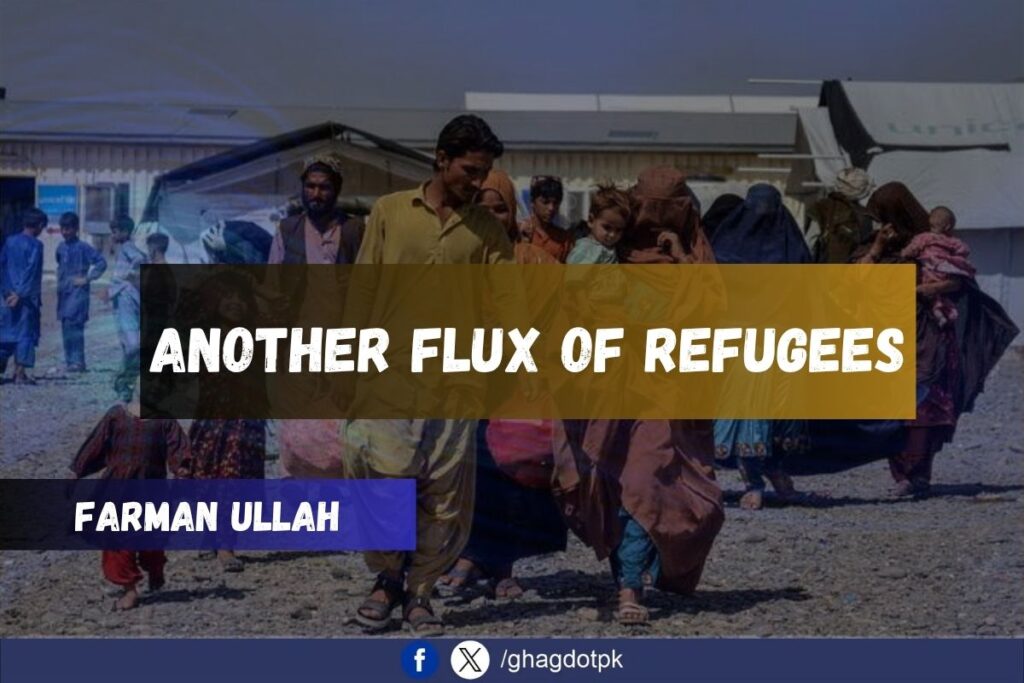By Farman Ullah
Pakistan’s experience with refugee influxes stretches back decades, from hosting millions of Afghans since the Soviet invasion to dealing with more recent mass arrivals. Each wave taught lessons—some painful—about economic burden, social cohesion, and security. Today, amid the rising tensions between Iran and Israel, Pakistan stands at the cusp of a potential new refugee crisis. The latest cross‑border escalation, with Israeli airstrikes and drone attacks reaching deep into Iranian territory, has triggered alarms at UNHCR and other humanitarian organizations. They warn of large-scale displacement inside Iran, particularly in southern and southeastern provinces near the Pakistan border, where civilians may flee preemptively or be forced out by conflict.
Such a flow would follow historic patterns: in 1979, Pakistan hosted around six million Afghans, straining infrastructure, pushing up housing and rental costs, overwhelming schools and clinics, and shifting labor market dynamics. Studies indicate refugee-dense areas saw healthcare usage jump over 150%, classroom sizes swell, and rental rates spike—undermining the living standards of low-income Pakistanis . Similarly, Bangladesh’s Rohingya camps reveal how sudden arrivals can fracture host communities, inflaming local tensions and overtaxing public services.
The economic pressure from a new displacement wave would come on top of existing strains. Pakistan, heavily reliant on energy imports, is already feeling the pinch of rising oil prices tied to Iran’s war posture. Inflation, already estimated at over 30%, could jump further, squeezing household budgets and stalling IMF-backed reforms. Foreign reserves, already fragile, cannot easily absorb additional borrowing. Pakistan’s prior experience shows refugee costs reach far beyond immediate relief: infrastructure maintenance, education, healthcare, and border security all demand funding—strains that deepen when international donors contribute only a fraction of what’s needed. In 2022, only about 25 percent of refugee-related funding came from international sources; Pakistan carried the rest from its constrained budget .
But the challenge transcends economics. Pakistan’s 959 km border with Iran, especially through Balochistan, is infamous for being porous. Decades of informal crossings, tribal migration, and smuggling have turned these areas into hotspots of insecurity. Iranian civilians entering Pakistan—planned or unplanned—could be accompanied by militant actors exploiting sanctuary or supply routes. Pakistan has seen this before: Afghan refugee settlements in past years became recruitment pools and logistical bases for militant and criminal networks, as intelligence agencies have repeatedly warned . Replacing humanitarian generosity with rigid enforcement risks provoking ethnic tensions and provoking armed spillover.
Pakistan’s limited financial capacity complicates response. The government is already repatriating Afghan nationals under an “Illegal Foreigners’ Repatriation Plan,” having deported hundreds of thousands by late 2024. That effort managed to create economic vacuums in sectors that employed them—agriculture, construction, retail—while costing billions in lost investment, tax revenue, and social grievance. Purchases of livestock, businesses, and homes by Afghan refugees abruptly reversed, leading to large-scale economic disruption and social friction
Similar dynamics may unfold with new Iranian refugee inflows, triggering shortages, labor market distortions, and housing crunches.
Already, Pakistan struggles under the weight of nearly 4 million Afghan refugees—only some registered and legally documented—and independent estimates suggest nearly half remain undocumented.
Among them, many contribute economically, notably in informal sectors like construction, manual labor, waste recycling, and small trade—adding roughly 40 percent to certain GDP metrics
Yet undocumented populations also contribute to smuggling—especially fuel, cell phones, and other goods across porous borders—undermining regulation and costing tax revenue .
Against this backdrop, another refugee wave would trigger a multi-layered shock. On the immediate front, Pakistan would need to establish entry checkpoints, health screening, shelters, and basic services. That would require funding, manpower, and coordination among ministries, provinces, and NGOs. Yet existing budgets are overstretched. Islamabad’s reliance on IMF loans and aid from Gulf countries and China offers little breathing room—any new commitments risk derailing macroeconomic stability.
On the societal front, communities already resent competition for jobs, services, and resources. Studies show refugee presence has aggravated local tensions: healthcare facilities operating at 175 percent capacity, children squeezed out of schools, and urban housing demand driving rents higher
In border regions, where state presence is weak and tribal bonds deep, unplanned settlements could intensify conflict, sectarian polarization, or criminal activity.
Security implications are severe. Militant groups like Jaish al-Adl have regularly operated across the Iran–Pakistan frontier. Pakistan’s past responses included fencing, infrared surveillance, and military action—but enforcing a peaceful refugee-driven border while maintaining security is far more complex. Intelligence reports have frequently linked insurgent violence to refugee flows; a balance of compassion and control will be vital, yet difficult to achieve.
Globally, Pakistan’s refugee burden exposes gaps in international assistance. UNHCR estimates it needs hundreds of millions of dollars annually to provide minimal support, yet major donors fund only a quarter of that requirement . As Iran deepens its humanitarian crisis, donor fatigue may increase—and regional dynamics may dissuade Western aid to Pakistan if viewed through the lens of Iran–Israel alignments.
To minimize damage, Pakistan must prepare now. It needs proactive planning: registration systems, camps, health services, camp schools, and labor stabilization schemes. It also must coordinate diplomatically—leveraging its ties with Iran, China, Saudi Arabia, UAE, and the U.S.—to secure funding, logistical support, and a diplomatic consensus that supports safe passage and humane treatment. Transparent border control measures, coordinated with UN agencies, could help distinguish asylum seekers from opportunistic migrants.
Lessons from past Afghan influxes show that early registration, equitable resource allocation, and inclusion of refugees in labor markets help mitigate social friction. Pakistan may consider initiatives like biometric work permits, humanitarian visas, skills training, and mobile clinics—reducing dependency on ad-hoc arrangements and curbing underground economies. International partners—especially UNHCR, IOM, World Bank, and bilateral donors—must be engaged immediately, with Pakistan presenting a clear, costed refugee response plan rather than reactive rhetoric.
Equally, Islamabad must manage domestic narratives. Framing refugees as temporary guests rather than economic threats can build societal goodwill. Civil society and media campaigns emphasizing shared humanity and regional solidarity can counter xenophobic rhetoric. Encouraging local-government engagement and NGO-led humanitarian corridors can help deliver services efficiently and reduce distrust.
Pakistan’s border settlements can also serve as strategic corridors, enabling Iran to relocate civilians safely if it commits to transit cooperation. Such coordination benefits both countries and signals Pakistan’s responsible regional role—a counterweight to allegations of instability or militancy.
The stakes are high: failing to prepare opens Pakistan to economic shocks—rising inflation, reduced growth, austerity pressures from lenders—and social unrest. Localized conflict, crime waves, and extremist recruitment could surge. Border insecurity could spill into broader provincial instability, disrupting CPEC projects and bilateral trade, especially if conflict overstretches military and police resources.
But with foresight and global backing, the refugee wave could become an opportunity. Skilled Iranians fleeing conflict may add to Pakistan’s workforce. Coordinated human mobility frameworks could generate revenue via temporary labor programs. Humanitarian stewardship can bolster Pakistan’s international standing, positioning it as a regional crisis-manager.
In this context, Pakistan must view the Iran–Israel war not just as distant conflict, but as a test of policy capacity, regional posture, and societal resilience. By building on past lessons, asserting early control, and engaging the global community, it can manage the next wave of migrants humanely and pragmatically—balancing humanitarian commitments with national security and economic stability.






